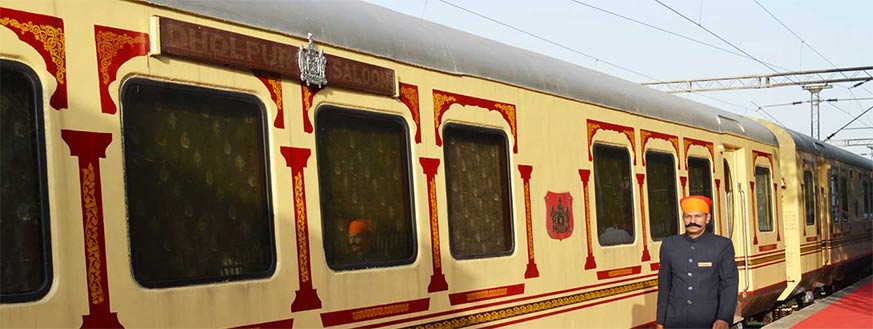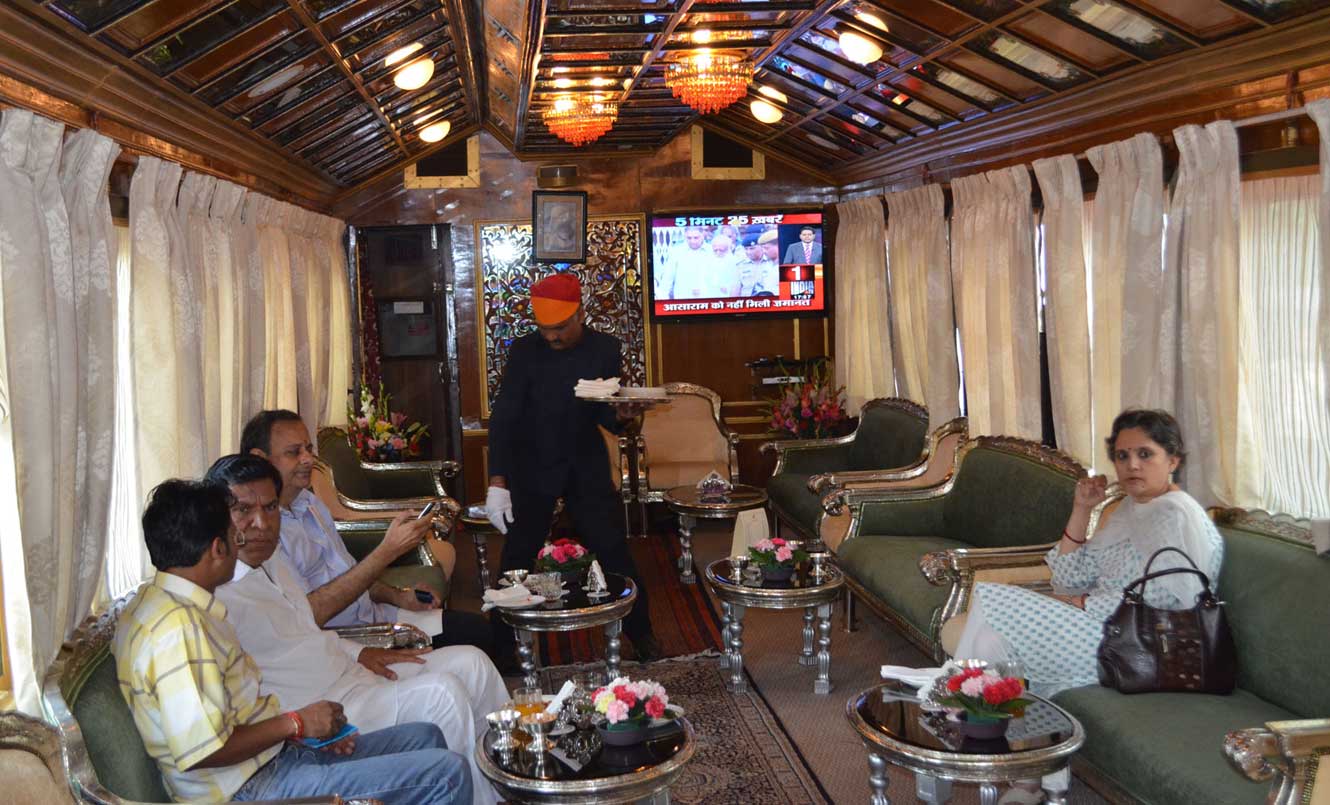The 14 guest carriages of Palace on Wheels are named after the former Rajputana states and exhibit the aesthetics and interiors of that particular region.
Following are the brief description of the 14 guest carriages provided in this luxury train –
Alwar:

In the medieval era, Alwar was the important place of trade & commerce. The ceiling of the Alwar Coach is aesthetically designed in cone work & relief oil, portraying a hunting scene. The hues of pink color dominate the interiors of the coach.
Bharatpur:
The Bharatpur coach exhibits the natural vividness of the region in their relief work that portrays various bird species on the tree of life. The theme of ‘nature’ is further enhanced by the inlay work done in white cedar that depicts birds & peacocks, sitting on a Haveli.
Bikaner:

In the Bikaner coach, the royal state crest is positioned on the valance along with the handicraft items. The ceiling portrays the legendary lovers Dhola & Maru on camel back. The décor and art work of the lounge is a seamless amalgam of Mughal & Bikaneri style.
Bundi:

Just like Bikaner coach, the royal crest of Bundi too is placed on the valance of the carriage. The ceiling depicts the oil painting of the famous Rang Mala, also known as Rag Ragini. In one of the guest cabins, an imposing structure approached by the pavement that lead up to the Hathi Pol, is depicted in water color.
Dholpur:

In the Dholpur coach, the fencing is made up of teak plywood and portrays the fine craftsmanship originally done in stone. The royal crest of Dholpur adorns the valance in zardozi work.
Dungargarh:

Dungargarh is a rugged region known for its tribal people and architecture. The ceiling exhibits the ‘lep’ work done by the tribal people on their house walls. It is done in a blend of relief and mirror work. The royal state crest appears on the valance, in Zardozi work.
Jaisalmer:

Jaisamler is a desert city famous for the Jaisalmer fort, intricate havelis and ancient Jain temples. The intricately trellis serves as the benchmark for the intricately carved jharokas displayed on the ceiling. The royal insignia is depicted on the valance.
Jaipur:

The décor of Jaipur coach takes its inspiration from the vibrancy of the state. The ceiling of the lounge is created using ‘Phad’ that is foil work that is a representation of various festivals such as Holi, Teej, Gangaur, Diwali etc. The emblem made on the valance, also oozes luxury as it is done in Zardozi work. The walls are adorned with miniature Jaipur style paintings. The ceilings have painted frescoes in a complementary color scheme of blue and gold.
Jhalawar:

Taking inspiration from kingdom, religion and culture of Jhalawar, this coach has ceilings that have been done in a medium that is used by the locals in the state for decorating their homes. It has an amalgamation of colors and a mirror work, used in the medium of plaster of paris that gives an attractive touch to the ambience. The royal motif adoring the valance has been done in zardozi work with handicrafts on the table tops of the lounge.
Jodhpur:

The coach of Jodhpur, takes its inspiration from the Mehrangarh Fort that has beautiful cusped arcades and designs influenced by the Mughal designs done at the Moti Mahal, which have been done in mother-of-pearl work on the ceilings of the coach. The royal badge on the valance of the lounge is done in distinctive of the Jodhpur School of Art with the miniature paintings.
Kishangarh:

Bani Thani paintings of Kishangarh are known for exaggeration of features like eyes and long fingers, that have been recreated in the paintings done on the ceiling of the coach using acrylic, along with enamel and foil. The crest done from zardozi on the blinds of the windows is placed along with an artwork of the Kishangarh school of Art highlighted on the wall of the lounge.
Kota:
Located beside the Chambal river, Kota has a grand setting and is well-known for the Kota school of design. All this form of the décor of this coach. The oil paintings named, ‘Raja aur Praja’ that is the King and his subjects done on the ceiling is inspired from these features. This painting shows Raja Ram Singh II of 15th century Kota with during a royal procession.
Sirohi:

The famous gold fort, near Pratapgarh with its colored glass work with Indo-European essence is the basis of this décor with highlighted framed works of art in typical style. The ambiance and color scheme is also impressive. The gold foil and glass work is done with semi-precious stones fixed in it. This has given out a mix media creation in cone and paint stamped particle boards with the royal insignia placed outstandingly. The unique miniatures are in Sirohi school style.
Udaipur:
This state lounge and its bedroom cabins take up its color scheme of while and blue from the courts, halls and halls of the City Palace, on the edge of Lake Pichhola. One of the most captivating courts is the Peacock Court that has peacocks modeled in high relief and made with colored glass mosaic. The interiors of lounge take its insight from the ‘Mor Chowk’ that is, the Peacock Court. It has a combination of the relief work and Patra (oxidized white metal work). The royal state crest placed on the valance of the blinds is made from zardozi work.



Comment (0)